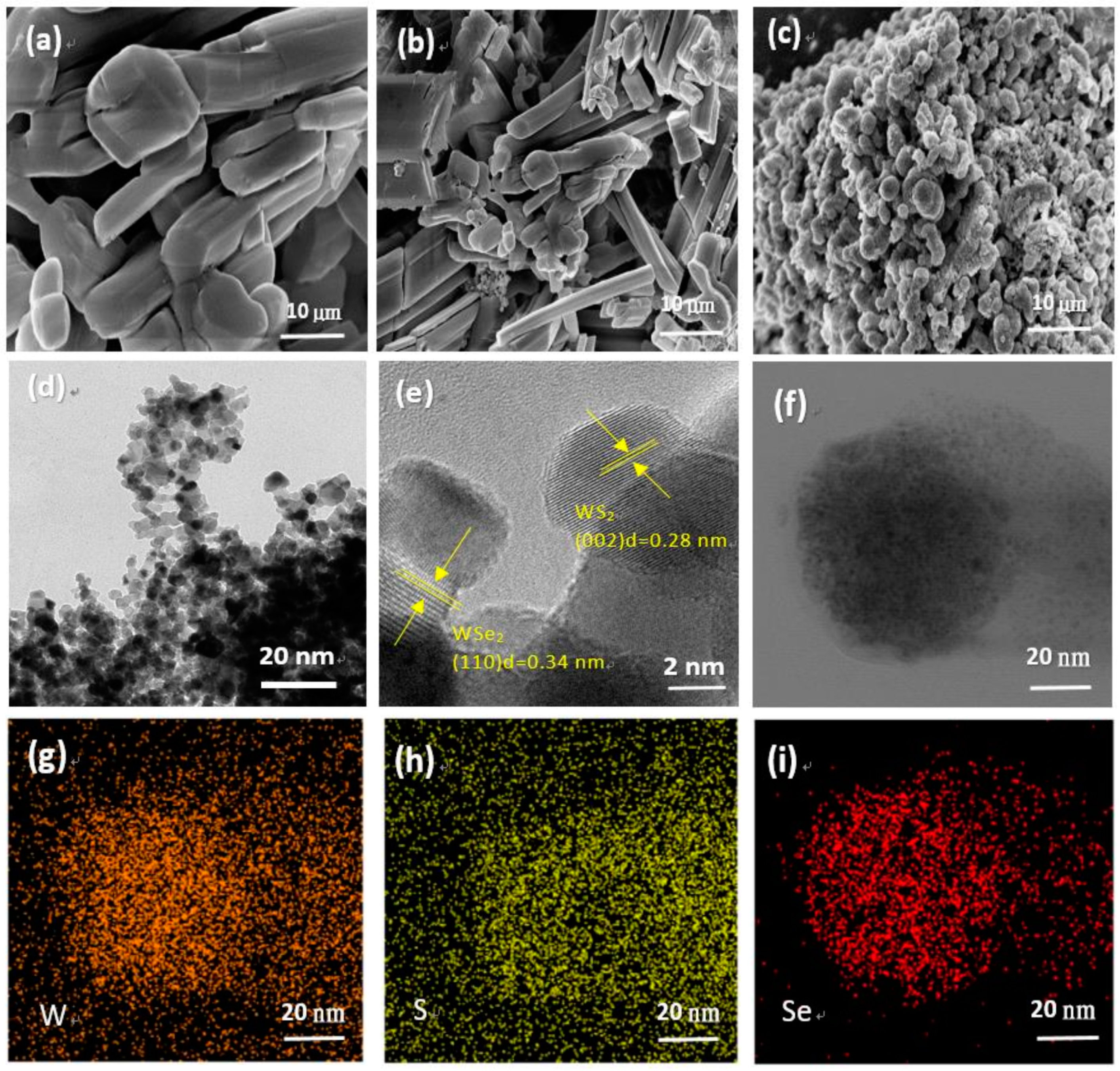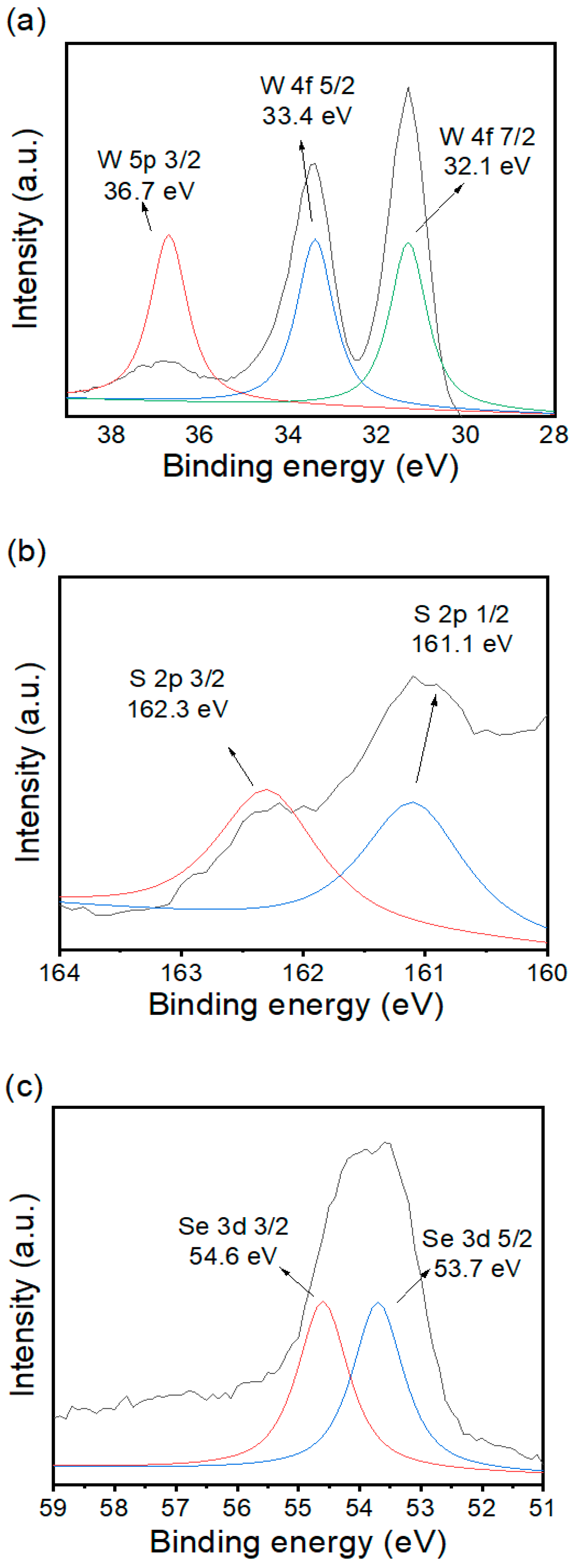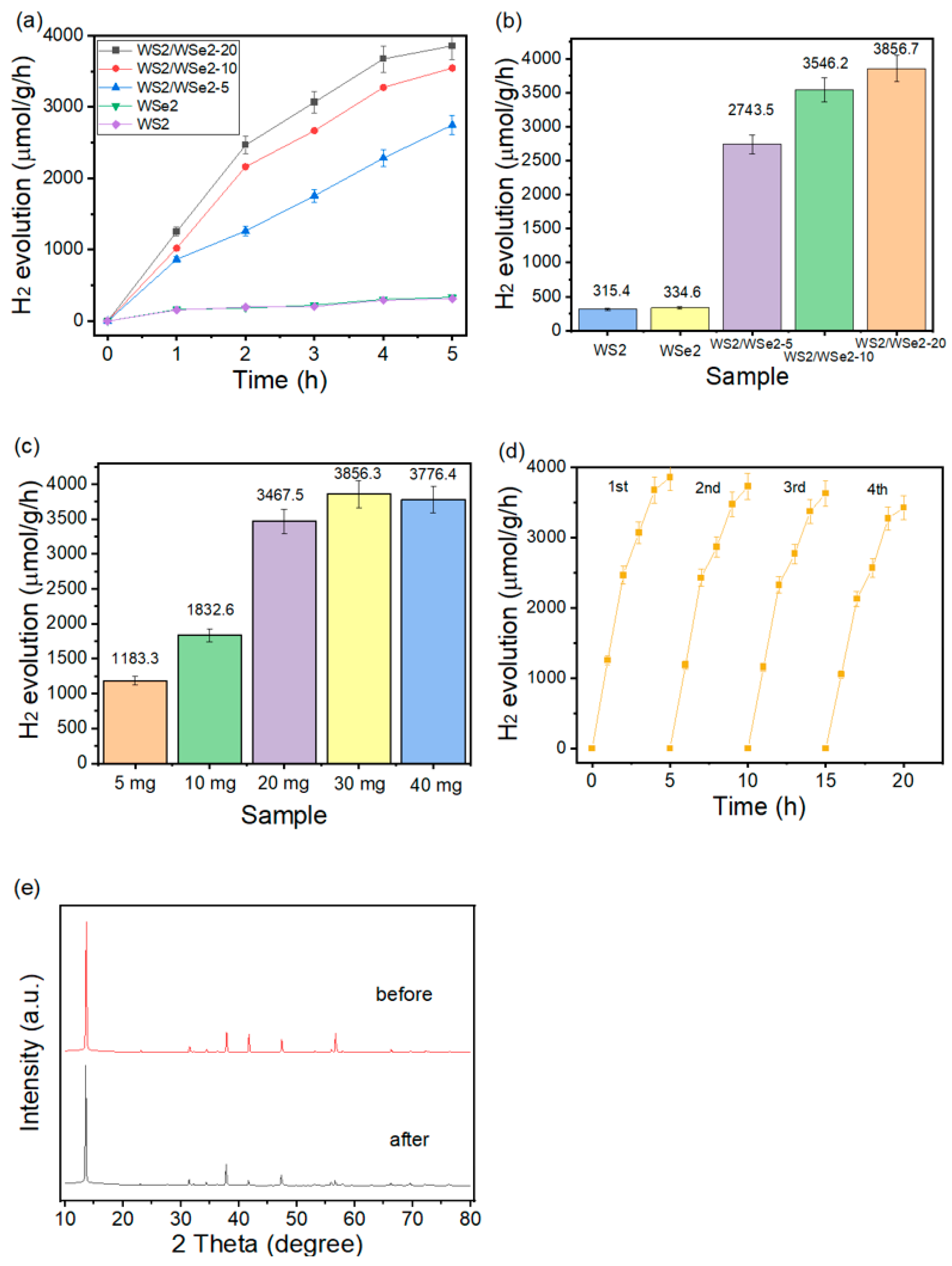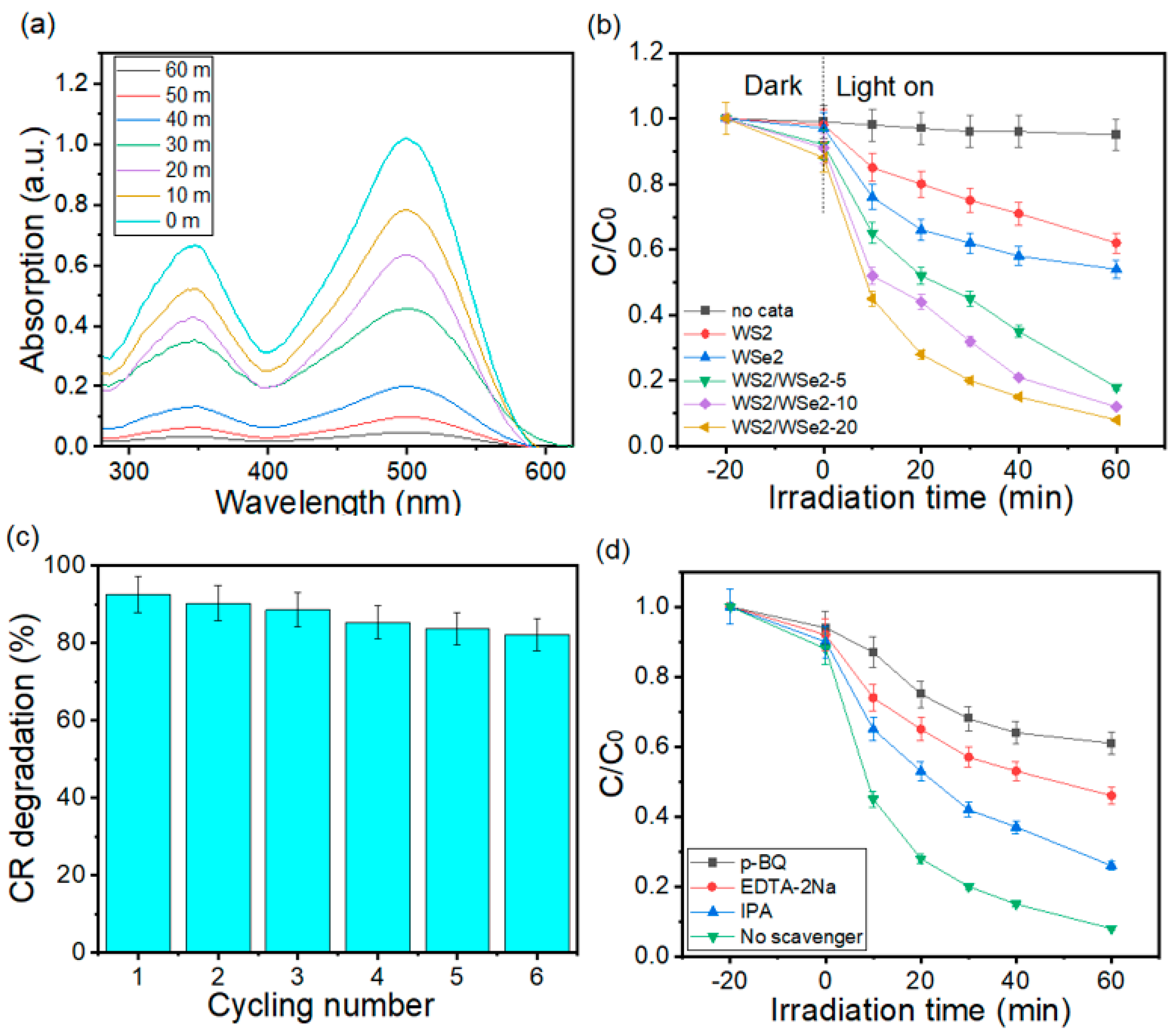Fabrication of WS2/WSe2 Z-Scheme Nano-Heterostructure for Efficient Photocatalytic Hydrogen Production and Removal of Congo Red under Visible Light
Abstract
:1. Introduction
2. Results
2.1. Microstructure Characterization
2.2. Hydrogen Production Behavior
2.3. CR Degradation Behavior
3. Materials and Methods
3.1. Preparation of Materials
3.2. Synthesis
3.3. Characterization
3.4. Photocatalytic Hydrogen Evolution Tests
3.5. Photocatalytic Activity Experiments
4. Conclusions
Author Contributions
Funding
Data Availability Statement
Acknowledgments
Conflicts of Interest
References
- Mersel, M.A.; Fodor, L.; Pekker, P.; Makó, É.; Horváth, O. Effects of Preparation Conditions on the Efficiency of Visible-Light-Driven Hydrogen Generation Based on Ni(II)-Modified Cd0.25Zn0.75S Photocatalysts. Molecules 2022, 27, 4296. [Google Scholar] [CrossRef] [PubMed]
- Irfan, M.; Ahmad, I.; Shukrullah, S.; Hussain, H.; Atif, M.; Legutko, S.; Petru, J.; Hatala, M.; Naz, M.Y.; Rahman, S. Construction of 0D/2D Schottky Heterojunctions of ZnO and Ti3C2 Nanosheets with the Enriched Transfer of Interfacial Charges for Photocatalytic Hydrogen Evolution. Materials 2022, 15, 4557. [Google Scholar] [CrossRef] [PubMed]
- Chen, L.J. Tunable photoluminescence emission from Cadmium Tellurium nanorods with ethylenediamine template-assistance at a low temperature. Mater. Lett. 2013, 101, 83. [Google Scholar]
- Hao, D.; Liu, Y.; Gao, S.; Arandiyan, H.; Bai, X.; Kong, Q.; Wei, W.; Shen, P.K.; Ni, B.J. Emerging artificial nitrogen cycle processes through novel electrochemical and photochemical synthesis. Mater. Today 2021, 46, 212–233. [Google Scholar] [CrossRef]
- Cai, M.; Cao, S.; Zhuo, Z.; Wang, X.; Shi, K.; Cheng, Q.; Xue, Z.; Du, X.; Shen, C.; Liu, X.; et al. Fabrication of Ni2P Cocatalyzed CdS Nanorods with a Well-Defined Heterointerface for Enhanced Photocatalytic H2 Evolution. Catalysts 2022, 12, 417. [Google Scholar] [CrossRef]
- Vadivel, D.; Sturini, M.; Speltini, A.; Dondi, D. Tungsten Catalysts for Visible Light Driven Ofloxacin Photocatalytic Degradation and Hydrogen Production. Catalysts 2022, 12, 310. [Google Scholar] [CrossRef]
- Zhurenok, A.V.; Markovskaya, D.V.; Gerasimov, E.Y.; Vokhmintsev, A.S.; Weinstein, I.A.; Prosvirin, I.P.; Cherepanova, S.V.; Bukhtiyarov, A.V.; Kozlova, E.A. Constructing g-C3N4/Cd1-xZnxS-Based Heterostructures for Efficient Hydrogen Production under Visible Light. Catalysts 2021, 11, 1340. [Google Scholar] [CrossRef]
- Chen, L.J.; Dai, J.H. Growth, morphological and optical characteristics of ZnSSe nanorods. Opt. Mater. 2017, 64, 356. [Google Scholar]
- Yin, S.; Liu, S.; Yuan, Y.; Guo, S.; Ren, Z. Octahedral Shaped PbTiO3-TiO2 Nanocomposites for High-Efficiency Photocatalytic Hydrogen Production. Nanomaterials 2021, 11, 2295. [Google Scholar] [CrossRef]
- Shahabuddin, S.; Mehmood, S.; Ahmad, I.; Sridewi, N. Synthesis and Characterization of 2D-WS2 Incorporated Polyaniline Nanocomposites as Photo Catalyst for Methylene Blue Degradation. Nanomaterials 2022, 12, 2090. [Google Scholar] [CrossRef]
- Chen, I.W.P.; Lai, Y.M.; Liao, W.S. One-Pot Synthesis of Chlorophyll-Assisted Exfoliated MoS2/WS2 Heterostructures via Liquid-Phase Exfoliation Method for Photocatalytic Hydrogen Production. Nanomaterials 2021, 11, 2436. [Google Scholar] [CrossRef] [PubMed]
- Luo, Z.; Li, Y.; Guo, F.; Zhang, K.; Liu, K.; Jia, W.; Zhao, Y.; Sun, Y. Carbon Dioxide Conversion with High-Performance Photocatalysis into Methanol on NiSe2/WSe2. Energies 2020, 13, 4330. [Google Scholar] [CrossRef]
- Varadwaj, P.R.; Varadwaj, A.; Marques, H.M.; Yamashita, K. Chalcogen Bonding in the Molecular Dimers of WCh2 (Ch = S, Se, Te): On the Basic Understanding of the Local Interfacial and Interlayer Bonding Environment in 2D Layered Tungsten Dichalcogenides. Int. J. Mol. Sci. 2022, 23, 1263. [Google Scholar] [CrossRef] [PubMed]
- Niu, Y.; Gonzalez-Abad, S.; Frisenda, R.; Marauhn, P.; Drüppel, M.; Gant, P.; Schmidt, R.; Taghavi, N.S.; Barcons, D.; Molina-Mendoza, A.J.; et al. Thickness-Dependent Differential Reflectance Spectra of Monolayer and Few-Layer MoS2, MoSe2, WS2 and WSe2. Nanomaterials 2018, 8, 725. [Google Scholar] [CrossRef] [PubMed] [Green Version]
- Deshmukh, S.M.; Patil, S.S.; Babar, S.B.; Alshehri, S.; Ghoneim, M.M.; Tamboli, A.M.; Lam, N.H.; Truong, N.T.N.; Kim, C.D.; Tamboli, M.S.; et al. TiO2–SnO2 Nanocomposites for Photocatalytic Environmental Remediation under UV-Light. Metals 2022, 12, 733. [Google Scholar] [CrossRef]
- Shehab, M.A.; Sharma, N.; Valsesia, A.; Karacs, G.; Kristály, F.; Koós, T.; Leskó, A.K.; Nánai, L.; Hernadi, K.; Németh, Z. Preparation and Photocatalytic Performance of TiO2 Nanowire-Based Self-Supported Hybrid Membranes. Molecules 2022, 27, 2951. [Google Scholar] [CrossRef]
- Chen, L.J.; Chuang, Y.J.; Chen, C. Surface passivation assisted lasing emission in the quantum dots doped cholesteric liquid crystal resonating cavity with polymer template. RSC Adv. 2014, 4, 18600. [Google Scholar] [CrossRef]
- Deshmukh, S.M.; Arbuj, S.S.; Babar, S.B.; Shaikh, S.F.; Tamboli, A.M.; Truong, N.T.N.; Kim, C.D.; Khetre, S.M.; Tamboli, M.S.; Bamane, S.R. Environmentally Benign Organic Dye Conversion under UV Light through TiO2-ZnO Nanocomposite. Metals 2021, 11, 1787. [Google Scholar] [CrossRef]
- Shelke, H.D.; Machale, A.R.; Survase, A.A.; Pathan, H.M.; Lokhande, C.D.; Lokhande, A.C.; Shaikh, S.F.; Rana, A.H.S.; Palaniswami, M. Multifunctional Cu2SnS3 Nanoparticles with Enhanced Photocatalytic Dye Degradation and Antibacterial Activity. Materials 2022, 15, 3126. [Google Scholar] [CrossRef] [PubMed]
- Nada, E.A.; El-Maghrabi, H.H.; Raynaud, P.; Ali, H.R.; El-Wahab, S.A.; Sabry, D.Y.; Moustafa, Y.M.; Nada, A.A. Enhanced Photocatalytic Activity of WS2/TiO2 Nanofibers for Degradation of Phenol under Visible Light Irradiation. Inorganics 2022, 10, 54. [Google Scholar] [CrossRef]
- Xu, F.; Hu, C.; Zhu, D.; Wang, D.; Zhong, Y.; Tang, C.; Zhou, H. One-Step Hydrothermal Synthesis of Nanostructured MgBi2O6/TiO2 Composites for Enhanced Hydrogen Production. Nanomaterials 2022, 12, 1302. [Google Scholar] [CrossRef] [PubMed]
- Safri, A.; Fletcher, A.J. Effective Carbon/TiO2 Gel for Enhanced Adsorption and Demonstrable Visible Light Driven Photocatalytic Performance. Gels 2022, 8, 215. [Google Scholar] [CrossRef] [PubMed]
- Edelberg, D.; Rhodes, D.; Kerelsky, A.; Kim, B.; Wang, J.; Zangiabadi, A.; Kim, C.; Abhinandan, A.; Ardelean, J.; Scully, M.; et al. Approaching the Intrinsic Limit in Transition Metal Diselenides via Point Defect Control. Nano Lett. 2019, 19, 4371. [Google Scholar] [CrossRef] [Green Version]
- Brasington, A.; Golla, D.; Dave, A.; Chen, B.; Tongay, S.; Schaibley, J.; LeRoy, B.J.; Sandhu, A. Role of defects and phonons in bandgap dynamics of monolayer WS2 at high carrier densities. J. Phys. Mater. 2021, 4, 015005. [Google Scholar] [CrossRef]
- Chen, L.J.; Chuang, Y.J. Quaternary Semiconductor Derived and formation mechanism by non-vacuum Route from Solvothermal Nanostructures for High-Performance application. Mater. Lett. 2013, 91, 372. [Google Scholar] [CrossRef]
- Hussien, M.S.A.; Bouzidi, A.; Abd-Rabboh, H.S.M.; Yahia, I.S.; Zahran, H.Y.; Abdel-wahab, M.S.; Alharbi, W.; Awwad, N.S.; Ibrahim, M.A. Fabrication and Characterization of Highly Efficient As-Synthesized WO3/Graphitic-C3N4 Nanocomposite for Photocatalytic Degradation of Organic Compounds. Materials 2022, 15, 2482. [Google Scholar] [CrossRef]
- Wang, J.; Yang, S. Superior Degradation Performance of Nanoporous Copper Catalysts on Methyl Orange. Metals 2021, 11, 913. [Google Scholar] [CrossRef]








| Samples | Specific Surface Area (m2/g, BET) a | Total Pore Volume (cm3/g, BET) b | Average Pore Diameter (nm, BJH)b |
|---|---|---|---|
| WSe2 | 33.6±5 | 0.182±0.02 | 38.4±5 |
| WS2 | 23.3±5 | 0.113±0.02 | 48.5±5 |
| WS2/WSe2-20 | 68.6±5 | 0.347±0.02 | 9.5±3 |
Publisher’s Note: MDPI stays neutral with regard to jurisdictional claims in published maps and institutional affiliations. |
© 2022 by the authors. Licensee MDPI, Basel, Switzerland. This article is an open access article distributed under the terms and conditions of the Creative Commons Attribution (CC BY) license (https://creativecommons.org/licenses/by/4.0/).
Share and Cite
Tien, T.-M.; Chung, Y.-J.; Huang, C.-T.; Chen, E.L. Fabrication of WS2/WSe2 Z-Scheme Nano-Heterostructure for Efficient Photocatalytic Hydrogen Production and Removal of Congo Red under Visible Light. Catalysts 2022, 12, 852. https://doi.org/10.3390/catal12080852
Tien T-M, Chung Y-J, Huang C-T, Chen EL. Fabrication of WS2/WSe2 Z-Scheme Nano-Heterostructure for Efficient Photocatalytic Hydrogen Production and Removal of Congo Red under Visible Light. Catalysts. 2022; 12(8):852. https://doi.org/10.3390/catal12080852
Chicago/Turabian StyleTien, Tsung-Mo, Yu-Jen Chung, Chen-Tang Huang, and Edward L. Chen. 2022. "Fabrication of WS2/WSe2 Z-Scheme Nano-Heterostructure for Efficient Photocatalytic Hydrogen Production and Removal of Congo Red under Visible Light" Catalysts 12, no. 8: 852. https://doi.org/10.3390/catal12080852
APA StyleTien, T.-M., Chung, Y.-J., Huang, C.-T., & Chen, E. L. (2022). Fabrication of WS2/WSe2 Z-Scheme Nano-Heterostructure for Efficient Photocatalytic Hydrogen Production and Removal of Congo Red under Visible Light. Catalysts, 12(8), 852. https://doi.org/10.3390/catal12080852






